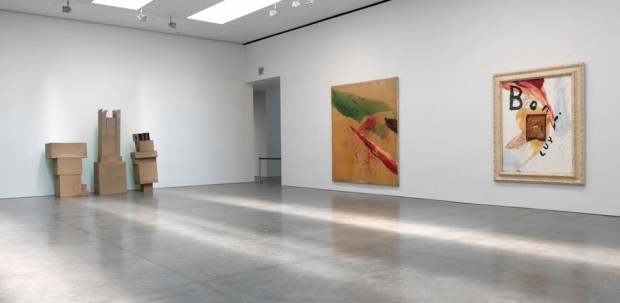Georg Baselitz, Anselm Kiefer, Harmony Korine, Robert Rauschenberg, Julian Schnabel, Rudolf Stingel, Franz West
Gagosian Gallery
555 West 24th Street
New York, NY 10011
Runs through July 18, 2014
What’s on view: Pretty much what you’d expect from a summer group show at Gagosian: monumental paintings, many with collaged elements, that you’d find in any major museum or private collection the world over.
Corinna: This is awful to say, but I can’t figure out if Gagosian has killed the art-going experience. When we arrived last week, the gallery was empty except for a family—VIPs, collectors of some sort—who were touching the Julian Schnabel. Security guards did nothing. I felt like crap because this exhibition was not for me. Gagosian’s galleries are not so much exhibition spaces as showrooms for potential buyers. Curating can be thrown to the wind when all you need is for the works to look good. But…the works do look good.
I even wanted to run up to the Franz West sculptures of two gooey, pastel-colored “boxers,” his “Caino va incontro ad Abele” from 2010, and bop around with them. They just seemed to have so much life to them, isolated away from everything in one of Gagosian’s airplane hangar-size rooms, except for a Harmony Korine painting hung on one wall. I can’t imagine that many U.S. museums would give a work like that enough space; it’d end up in a collection show, shoved into a corner just a few feet away from several other works. So Gagosian: sometimes good, sometimes bad.
Whitney: I didn’t even think the works looked that good. Any interior life in art just dies when it’s arranged solely by size and color. In this arrangement, even Georg Baselitz’s gum-colored Neo-Expressionism and Robert Rauschenberg’s cardboard box collages looked infinitely reproducible in different varieties. The show title is just a list of artist names. There is no press release. This is just inventory.

Installation view of Robert Rauschenberg’s, “Cardboard-Box Constructions” and Julian Schnabel’s, “Boni Lux” series. Courtesy Gagosian Gallery
Paddy: I thought those Georg Baselitz pieces were pretty good! Neo-Expressionism looks reproducible by definition, but I think the monumentality of that painting and his gestures really held the wall. His use of black in Lehr nich ratte much wilm (Lelf bal wile) is bold in this painting, which is otherwise filled with light colors and creating a balance with a palette like that takes some expertise. I’m loathed to say it after all of those masochistic comments the artist has made about how women can’t make good paintings, but these pieces demonstrate that he can paint.
Corinna: Oh, it was just the amply space and the light that made them look “good.” It’s a subjective issue, I know.
Paddy: In any event, I get that this is just an inventory show, but I don’t think this looks that much different than the inventory shows they have up on 77th street all the time. Which is to say, the works weren’t that bad. Gagosian showed a chunky black Anselm Kiefer painting that looked like the artist was mapping out the night sky with text. It was massive, and you could feel the weight of the sky. There was an unremarkable black and white Rudolf Stingel painting, but Corinna’s right about those Franz West sculptures. They’ve got a lot of life to them and you can really see their influence on artists like Rachel Harrison, Jose Lerma, and even more emerging artists like Rachel de Joode. I mean, that’s not nothing.
Whitney: No, it’s not nothing, and the works aren’t bad at all, on their own. But “not bad” is a pretty low bar for, say, a Rauschenberg, and I think you have to have better memories with the art to draw from to have an experience here. How would I have any idea that Rudolf Stingel’s enormous black and white mountain is a memory of his birthplace, Merano, in the Tyrolean Alps– and not just a straightforward picture of a mountain? There’s no information, and none of the other work seems to communicate with it, so it just feels like Gagosian dropped Anselm Kiefer’s nearby “Wasserman”, the night sky painting you’d mentioned, into a visually-similar google search and picked it out that way. Those Franz West sculptures are definitely a playful high point, but for me, the narratives and references are lost to visual candy. There’s little here that leads you to further investigation.





Comments on this entry are closed.